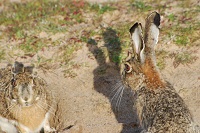
Competition, predation, and diseases are key factors shaping animal communities. In recent decades, lagomorphs in Europe have been impacted by virus-borne diseases that have caused substantial declines in their populations and, subsequently, in many of their predators. We examined activity and habitat-use patterns of sympatric European rabbits (Oryctolagus cuniculus) and Iberian hares (Lepus granatensis) in Doñana National Park, during two periods of disease outbreak.
In the first period (1984–1985), fecal pellet counts and roadside counts indicated that lagomorph species were segregated, with rabbits occurring in scrublands and hares in marshlands. Both species also occupied rush and fern belt ecotones. Roadside counts at sunrise, midday, sunset, and midnight revealed that rabbits and hares had the same activity patterns (crepuscular and nocturnal) in the zone of sympatry. During the second period (2005–2016), roadside counts showed that rabbits and hares were mainly nocturnal in scrublands and border marshlands. Hares occupied scrublands, a habitat previously occupied only by rabbits. These results are interpreted in the context of the competition theory and predation pressure. The disease-caused decline of rabbits has likely favored hares that moved into scrublands, a vegetation type previously occupied exclusively by rabbits.
The decline of rabbits in the Doñana National Park has also caused the almost disappearance of this area of the Iberian lynx (Lynx pardinus), a rabbit specialist, thus enabling generalist predators to increase. Generalist predators have subsequently increased predation pressure on both rabbits and hares, causing them to switch to nocturnal activity.
This study has been recently published in the journal Land and can be found in the following link, https://www.mdpi.com/2073-445X/11/4/461 .
https://www.mdpi.com/2073-445X/11/4/461 


